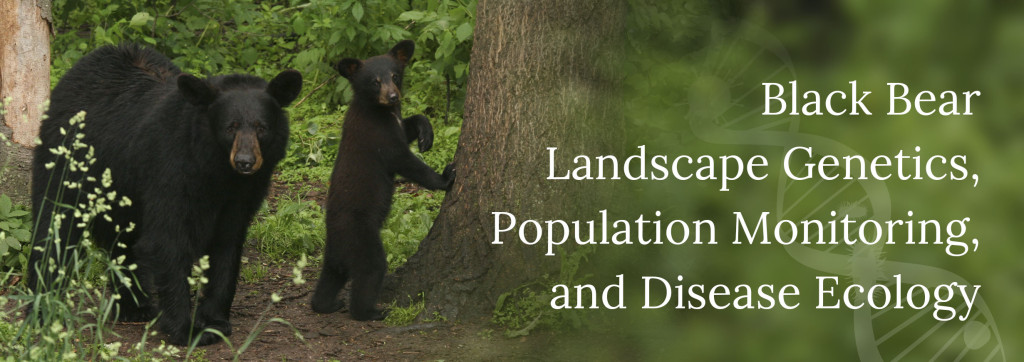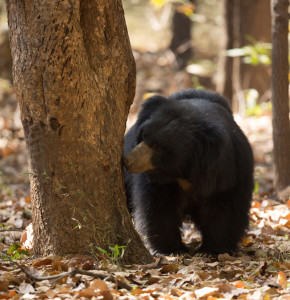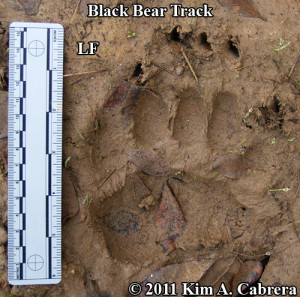Black Bears
Black Bears

Lab researchers: Holly Ernest, Kyle Gustafson, Laura Johnson, Bruce Hoar, Millie Vazquez,
An estimated 30,000 (and increasing) black bears (Ursus americanus) occupy a variety of habitats in California. Previous to our work, population units and dynamics were unknown on a state-wide level. In an analysis of DNA of 540 black bears across California, our lab and collaborators discovered distinct population structure and genetic evidence of 2 historic colonization events (Brown et al 2009). First, DNA types (genotypes) of bears sampled in southern California are most related to those from the Yosemite National Park region and not with spatially intervening populations. Historical records recount the translocation of 28 black bears from the Yosemite National Park area of the central Sierra Nevada to the San Bernardino Mountains in southern California in the 1930s. The genetic data confirmed that bears living today carry that Yosemite translocation genetic signature.

Second, before colonization of California by Europeans, the Central Coast region was inhabited by the now extinct California grizzly bear (Ursus arctos californiensis), but not many black bears. Following an apparent competitive release and range expansion during the past century, black bears now increasingly inhabit the Central Coast. These Central Coast black bears display lower genetic diversity (founder effect) and a genetic signature most closely allied with black bears from the southern Sierra Nevada. In both these cases, molecular genetic techniques allowed historical reconstruction of anthropogenic events leading to changes in animal distributions.
Sarah Brown (now geneticist for Washington State Fish & Wildlife), in our lab during mid-2000’s worked with Holly on our first CA black bear genetics project, culminating in a paper in Journal of Mammalogy, Brown et al. 2009 (see below).
Jamie Sherman in our UC Davis lab, worked on our second major black bear project during 2010 – 2017 and has generated detailed new genetic data for the Central Coast to help wildlife and land managers better understand bear population dynamics. Working with the California Department of Fish and Wildlife, Jamie used molecular mark-recapture (DNA from hair) to estimate numbers of black bears. When a bear left its hair a second time near a sampling site, Jamie detected that bear multiple times via the DNA trace it left (therefore the “mark-recapture” name of the technique) … tracking bears non-invasively through hair they leave behind. Stay tuned for upcoming papers.
Kyle Gustafson and Millie Vazquez worked on our third major bear genetics study (2016-2019), funded and in collaboration with California Department of Wildlife (CDFW) biologists and environmental scientists. The focus in this study is to examine bear numbers, landscape genetics in three main regions of CA: 2 mountain ranges near Los Angeles, and in the eastern Sierra Nevada following up on work that we and Jonathan Fusaro conducted for his MS at Utah State University.
Next in 2020-2022, with Dr. Kyle Gustafson, Laura Johnson, and Dr. Bruce Hoar (DVM, PhD, fresh from 2021 MS in Geomatics from UBC), we worked on our forth major bear genetics study, adding more genetic and ecologic detail to estimate black bear numbers and molecular mark-recapture landscape genetics in three main regions of CA: the San Bernardino Mountains near Los Angeles, and the Inyo and Mono county regions of the Sierra Nevada. Funded and collaboration provided by California Department of Wildlife (CDFW) biologists and environmental scientists.
Black Bear Disease Ecology in California
- Jamie Sherman worked to develop a diagnostic test to determine the presence of a parasite dangerous to people, called Trichinella (the reason wildlife meat and pork should be well-cooked, so humans don’t contract it).
 Black Bear state-wide population genetics in California
Black Bear state-wide population genetics in California
- Comparing urban and wildland bear densities with a DNA-based capture-mark-recapture approach. 2017. Jonathan L. Fusaro, Mary M. Conner, Michael R. Conover, Timothy J. Taylor, Marc W. Kenyon Jr., Jamie R. Sherman, Holly B. Ernest. Human-Wildlife Interactions journal. Vol 11. 2017.
- Brown SK, Hull JM, Updike D, Fain S, Ernest HB. 2009. Black Bear Population Genetics in California: Signatures of Population Structure, Competitive Release and Historical Translocation. Journal of Mammalogy. 90:1066–1074.
Information from this research is having on the ground positive impacts to aid how black bears are managed and conserved. We collaborated with California Department of Fish and Game, US Fish and Wildlife Service Forensic Laboratory, United States Department of Agriculture-Wildlife Services, National Park Service (NPS) and independent researchers.
Resources
- For more information about Black Bears in California, see the California Department of Fish and Wildlife Page
- For information on Black Bears in the Rocky Mountains, see http://www.bebearaware.org/
- For bear and other nature photos: www.flickr.com/photos/natureali
- For bear tracking signs and photos: http://www.bear-tracker.com/

